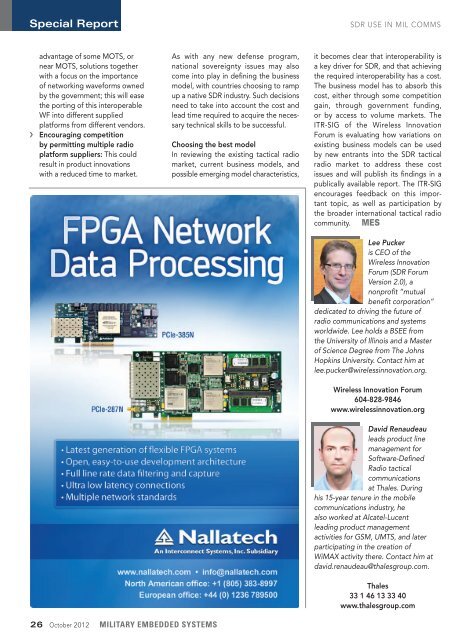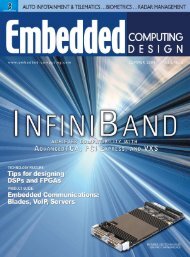Software-Defined Radio technology and market outlook
Software-Defined Radio technology and market outlook
Software-Defined Radio technology and market outlook
Create successful ePaper yourself
Turn your PDF publications into a flip-book with our unique Google optimized e-Paper software.
Special Report<br />
SDR USE IN MIL COMMS<br />
advantage of some MOTS, or<br />
near MOTS, solutions together<br />
with a focus on the importance<br />
of networking waveforms owned<br />
by the government; this will ease<br />
the porting of this interoperable<br />
WF into different supplied<br />
platforms from different vendors.<br />
››<br />
Encouraging competition<br />
by permitting multiple radio<br />
platform suppliers: This could<br />
result in product innovations<br />
with a reduced time to <strong>market</strong>.<br />
As with any new defense program,<br />
national sovereignty issues may also<br />
come into play in defining the business<br />
model, with countries choosing to ramp<br />
up a native SDR industry. Such decisions<br />
need to take into account the cost <strong>and</strong><br />
lead time required to acquire the necessary<br />
technical skills to be successful.<br />
Choosing the best model<br />
In reviewing the existing tactical radio<br />
<strong>market</strong>, current business models, <strong>and</strong><br />
possible emerging model characteristics,<br />
it becomes clear that interoperability is<br />
a key driver for SDR, <strong>and</strong> that achieving<br />
the required interoperability has a cost.<br />
The business model has to absorb this<br />
cost, either through some competition<br />
gain, through government funding,<br />
or by access to volume <strong>market</strong>s. The<br />
ITR-SIG of the Wireless Innovation<br />
Forum is evaluating how variations on<br />
existing business models can be used<br />
by new entrants into the SDR tactical<br />
radio <strong>market</strong> to address these cost<br />
issues <strong>and</strong> will publish its findings in a<br />
publically available report. The ITR-SIG<br />
encourages feedback on this important<br />
topic, as well as participation by<br />
the broader international tactical radio<br />
community. MES<br />
Lee Pucker<br />
is CEO of the<br />
Wireless Innovation<br />
Forum (SDR Forum<br />
Version 2.0), a<br />
nonprofit “mutual<br />
benefit corporation”<br />
dedicated to driving the future of<br />
radio communications <strong>and</strong> systems<br />
worldwide. Lee holds a BSEE from<br />
the University of Illinois <strong>and</strong> a Master<br />
of Science Degree from The Johns<br />
Hopkins University. Contact him at<br />
lee.pucker@wirelessinnovation.org.<br />
Wireless Innovation Forum<br />
604-828-9846<br />
www.wirelessinnovation.org<br />
David Renaudeau<br />
leads product line<br />
management for<br />
<strong>Software</strong>-<strong>Defined</strong><br />
<strong>Radio</strong> tactical<br />
communications<br />
at Thales. During<br />
his 15-year tenure in the mobile<br />
communications industry, he<br />
also worked at Alcatel-Lucent<br />
leading product management<br />
activities for GSM, UMTS, <strong>and</strong> later<br />
participating in the creation of<br />
WiMAX activity there. Contact him at<br />
david.renaudeau@thalesgroup.com.<br />
Thales<br />
33 1 46 13 33 40<br />
www.thalesgroup.com<br />
26 October 2012 MILITARY EMBEDDED SYSTEMS
















